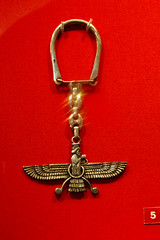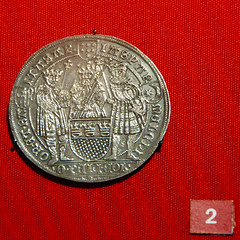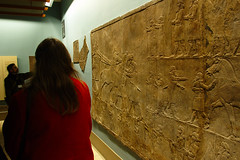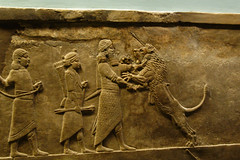Games Britannia
This is a three part series about the history of games in Britain, presented by Benjamin Woolley – we only recorded the first one which was the earlier history. Just as well, I think as he got closer to the modern day I’d’ve got more irritated with him (a throwaway remark in his intro to the theme of the series about how “these days teenage boys play video games” put my hackles up …). Other infelicities included showing a picture from an Egyptian relief of a game of senet and talking about it as if it was an ancestor of chess (unlikely, I think it’s believed to be more like a race game than a war game). And an assumption that an Iron Age game board must’ve been for divination purposes and meant this burial was of a druid … which, er, why does everything “primitive people” do have to have deep religious significance? Can’t a game be a game?
Otherwise it was an interesting survey of games from Iron Age Britain to late Victorian times. The earlier periods are represented by a small handful of games we don’t really know the rules for any more, except Nine Men’s Morris – which you find boards for scratched into the stonework in cathedral cloisters & so on, and it’s a game that is found in some variant form or another right across the world. The games we’d recognise today start to come in after contact with the east – some brought back by crusaders etc and later from India. I didn’t know that Snakes & Ladders derived from a Hindu game that was more of a teaching tool about the Hindu religion that a game per se. Odd to note that this game was altered to remove the message behind it during the same time period that teaching games were being churned out by Victorian moralists – lots of games where the point was to race to the end and there’d be various moral snares along the way (“You landed in a tavern, miss two goes”).
Nelson’s Caribbean Hell-hole: An Eighteenth Century Navy Graveyard Uncovered
A hurricane in 2010 uncovered 18th Century bones on a beach in Antigua – a place that Horatio Nelson once referred to as a “vile place” and a “dreadful hole”. In this programme Sam Willis followed the (fairly short) archaeological excavation that followed the discovery & told us a bit about the history of Antigua and why it was such an appalling place in the 18th Century. Antigua was important to the British Empire – both strategically and because it, in common with the other Caribbean islands, was where sugar was produced. The beach where the bones were found is in a place now called English Harbour – a natural harbour surrounded by hills where ships could shelter from the hurricanes. An obvious place to make your main base for the area – a couple of forts near the entrance & you can make the whole thing a safe place for your fleet. But the lack of wind & currents causes other problems – anything flung in the water just stays there. Parts of the seabed in the harbour today are feet thick in rubbish, industrial waste from the dockyards went in, any waste from the ships moored there including sewage. So instead of the pretty & clean beach of today the harbour would’ve been a stinking miasma of polluted water & air. Then you add in all the tropical diseases the sailors were exposed to, and the high mortality rate starts to seem reasonable. But then Willis talked to several archaeologists who have an additional theory about what was killing the sailors – lead poisoning from rum. Part of the sugar cane harvest was made into rum, and this was a staple drink for the sailors – they’d have a pint a day as part of their rations. But the rum was made in lead piping and lead distillation tanks, and the people Willis spoke to said the rum would’ve been contaminated. Perhaps not a problem if you had a bit now & again, but for the sailors it would’ve built up quickly.
The archaeological side of the programme was well covered, but was made at an early stage of the investigation – they had a few days of excavation but obviously hadn’t done any further analysis by the time the programme was made. But in that 5 days or so they got half a dozen skeletons from one small trench in the beach – the thought is that if a sailor died on board a ship in the harbour then he’d be hurriedly buried on the beach.
The Viking Sagas
This programme about the Viking Sagas wasn’t one of Janina Ramirez’s better programmes – somewhat padded out with lots of gushing about how wonderful the sagas were (rather than more discussion of the things themselves) at the start and some odd choices for imagery. It did get better as the programme went on, however, as we moved from generic “ooh this is wonderful” to a discussion of one saga in particular. The saga she chose was the Laxdæla saga, a story of lust, love & revenge. The point Ramirez was drawing out was that the Viking sagas were much more realistic than contemporary European literature which was heavy on tales of courtly love, and virtue being rewarded. The sagas are based on real events (in real places) with only a thin veneer of Christian moralising added at a later stage (like Guðrún, one of the protagonists, withdrawing to a nunnery at the end of her life in repentance). Ramirez also made a point of how British people were among those who settled Iceland (mostly women brought as concubines, i.e. sex slaves). And the sagas also influenced more modern British writers – Blake and Tolkein were the examples used.
Worth watching for the scenery & to hear bits of the saga read aloud (in Icelandic, with subtitles) in said scenery. But the In Our Time we listened to earlier in the year on the same subject was more informative (post).
The Ottomans: Europe’s Muslim Emperors
In the second episode of this series about the Ottoman Empire, Rageh Omaar covers the second half of the empire from Suleiman the Magnificent (or Suleiman the Lawgiver) in the 16th Century through to Abdul Hamid II and the “Sick Old Man of Europe” (nickname for the empire) in the 19th Century. Omaar continues to be more of an apologist for the Ottoman Empire than I’d like (lots of “it was a tolerant place” while glossing over second class citizenship for non-Muslims & children of non-Muslims being taken to be slaves). It was during Suleiman’s time that the Mamluk Empire was conquered – bringing the heartlands of Islam under Ottoman control. Prior to this the Ottomans were only really nominally Muslim, and ruled over a predominantly Christian territory, afterwards they moved more towards embracing their Islamic faith as a mark of their legitimacy as rulers. The Sultan was now also the Caliph, and they imposed a hierarchy on the Islamic clergy where there was previously no such thing. Under Suleiman and his immediate successors the Ottoman Empire pushed its expansion westward – ending up at the gates of Vienna, where they were only defeated by all of Christendom coming together (in effect) to drive them back. The Turks were feared across Europe & from the perspective of Europeans it was very much a Holy War (but not so from the Ottoman perspective, that was about territory). Omaar pointed out that this historical legacy influences the way the more eastern countries of Europe see the prospect of Turkey joining the European Union to this day.
Suleiman’s Ottoman Empire was at its peak, after him & his immediate successors their technological advantage started to be outstripped by a Europe undergoing the Industrial Revolution and entering the Enlightenment era. When Napoleon took his army to Egypt the initial Ottoman reaction was an assumption they were clearly the superior civilisation so their rout by the French & the loss of Egypt was a complete shock. It’s all downhill from there – the Ottomans end up referred to as the Sick Old Man of Europe, and rising nationalist feelings start to tear apart the cohesion of the Empire. The Ottoman dynasty is also seen by parts of the Empire as not Muslim enough – a fundamentalist Muslim group rising in what’s now Saudi Arabia took control of Mecca & Medina for a while, and whilst their rebellion was put down by the Ottomans it was a sign of what was to come.
Which is presumably the subject of the next episode.
Metal: How it Works
Metal: How it Works is the first of a three part series (all called X: How it Works) presented by Mark Miodownik which look at the materials our civilisation is based on. It was a combination of history, engineering & metallurgy, and while it could’ve been quite dry it was saved by the fact that Miodownik is engagingly enthusiastic about the subject. Miodownik took us through the history of metal-working from the early discovery of copper, and then bronze, through iron-working to steel and more modern metals. Along the way he talked about what it is about the atomic structure of metals that makes them behave the way they do (atoms in a crystal lattice, but one where the atoms can slide along and bunch up). As well as the enthusiastic bits about what metal working has let us do there were also a couple of segments about times when our ambition outreached our knowledge & skills. The first of these was about the railway bridge across the Tay, which collapsed under a train during a storm killing everyone on board. Which was the impetus for figuring out steel production – because it was the first indication for Victorian engineers that iron alone wasn’t necessarily the answer to all the world’s engineering problems. And the second was the first passenger planes, where tragically the stresses that repeated pressurisation & depressurisation put on the metal fuselages of planes was only worked out after several catastrophic mid-air failures.
Stories from the Dark Earth: Meet the Ancestors Revisited
The third episode of Stories from the Dark Earth was a very padded hour about two Iron Age burials. Very very padded. Bourton-on-the-Water is a village in the Cotswolds that I’ve been to several times as a child, and apparently underneath its primary school there is a fairly large Iron Age site. As the school has expanded they’ve had archaeologists come in and excavate before they put new buildings up, so much has been unearthed. The original burial (a girl in a rubbish pit) was thought to be singular and perhaps a sign of human sacrifice – so the updated info was first debunking that theory and then discussing the other burials they found in the area. All were of women or girls who were in some way diseased or disabled – they speculate that this may’ve been what set these women apart so that they were buried rather than excarnated (left to decompose before burying the bones). One of the bodies was of an older woman who had clearly been paralysed below the waist for several years (her leg bones were withered) but was otherwise in good health (as far as they could detect) which is an indication that these women were well looked after.
The other burial was a chariot burial found in Yorkshire in a village called Wetwang. Subsequent to the original excavation they’ve found evidence that the chariot was in use before death – ie it wasn’t just for burying the woman with, it was her vehicle in life. The woman in the grave was also disfigured, her skull was lopsided – probably pushed that way by a fairly large hemangioma on one of her cheeks. (Wikipedia says haemangiomas disappear over time mostly going by age 10, so perhaps I misremember what they said on the programme as they seemed to be saying it would still be visible in her later years.) She was buried with a mirror, which they’ve now discovered may’ve been kept in an otter fur bag – which may have symbolic status.
We’ll have a gap before we can watch the fourth episode, for some reason it didn’t record last time it aired so I need to wait till it airs again (soon, I think). In it, I suspect he’ll tell us several hundred times how it’s been “over N years since” the original excavations 😉
A Hundred Years of Us
The third episode of A Hundred Years of Us was more of the same mixture as the other two. Phil Tufnell was irritating as a butler this time (but the butler teaching him was too polite to outright laugh). More interesting was the segment on motorways – brand shiny new in the 1950s and requiring informational films about how you shouldn’t do a U-turn if you missed your exit nor have a picnic on the hard shoulder. And they were empty! There was also an interview with a man who’d moved from Jamaica to England in the early 60s (not on the Windrush, his parents moved over on the Windrush). He talked about both the culture shock and the racism he faced – like how he’d corresponded with an agricultural college when he was still in Jamaica to organise becoming a student once he moved to England. But once he turned up (and turned out black) there was magically no space in any of the classes. He ended up having to get a job as a bus conductor in Birmingham. He was keen to stress how much England has changed for the better since he arrived (although this segment also covered how much it got worse before it got better).



















